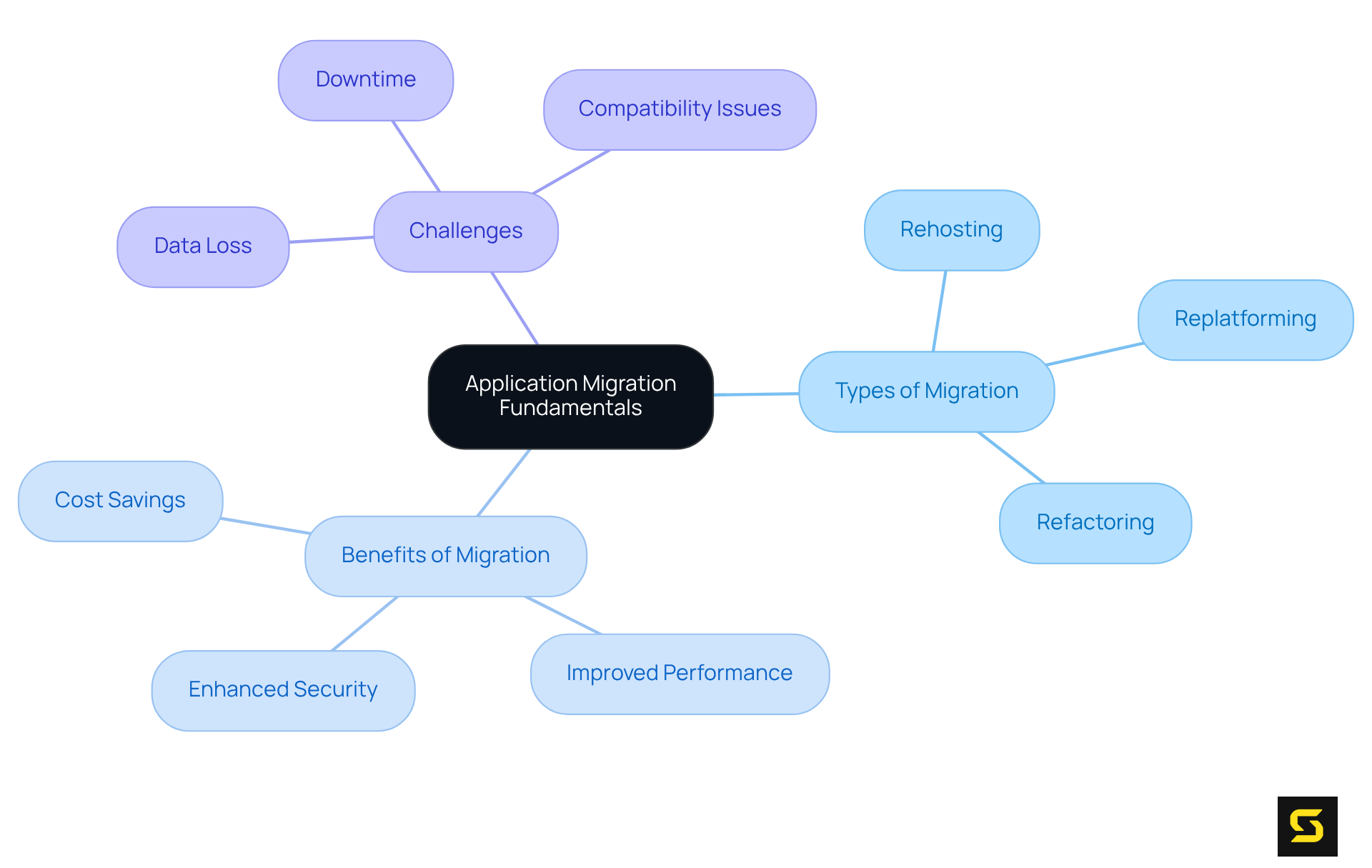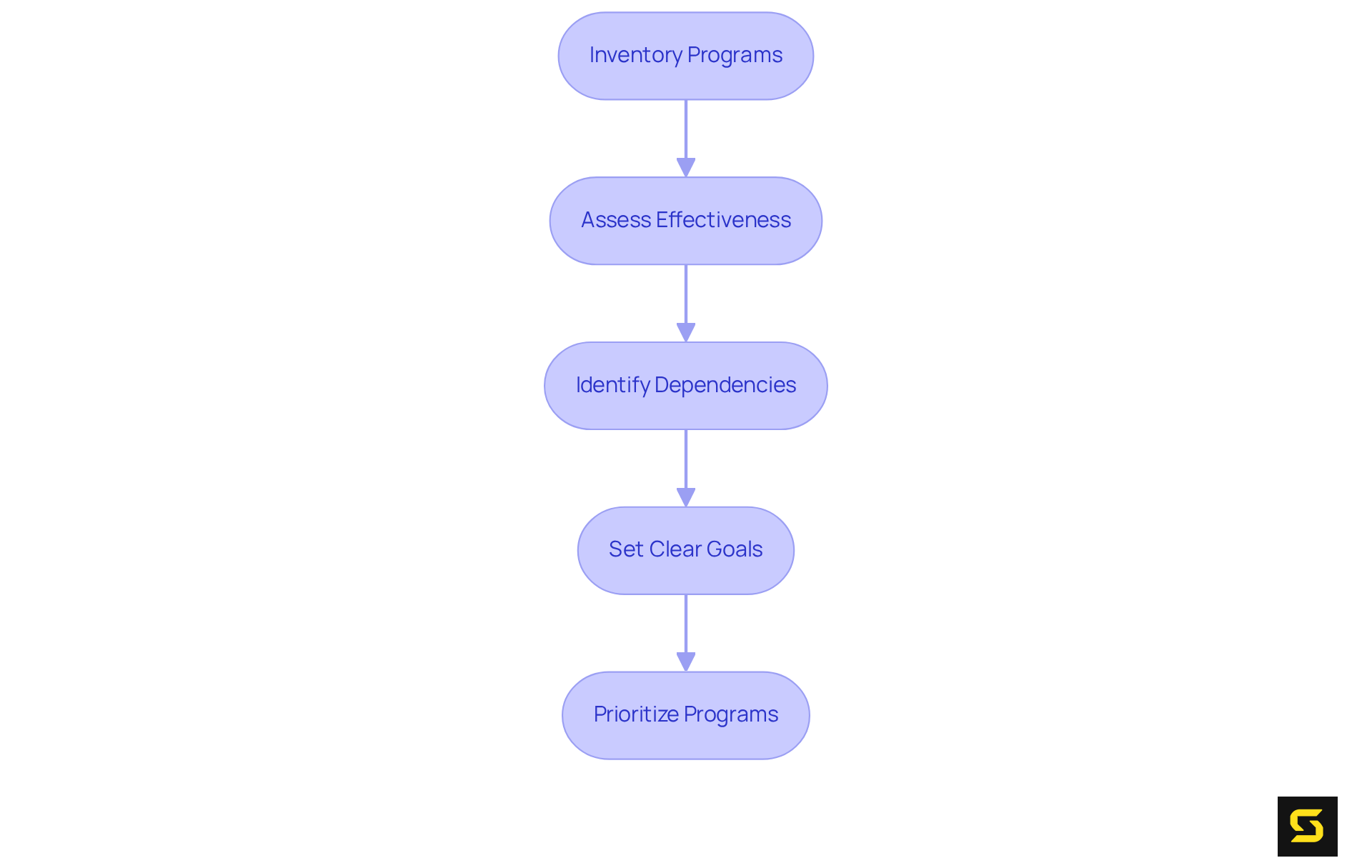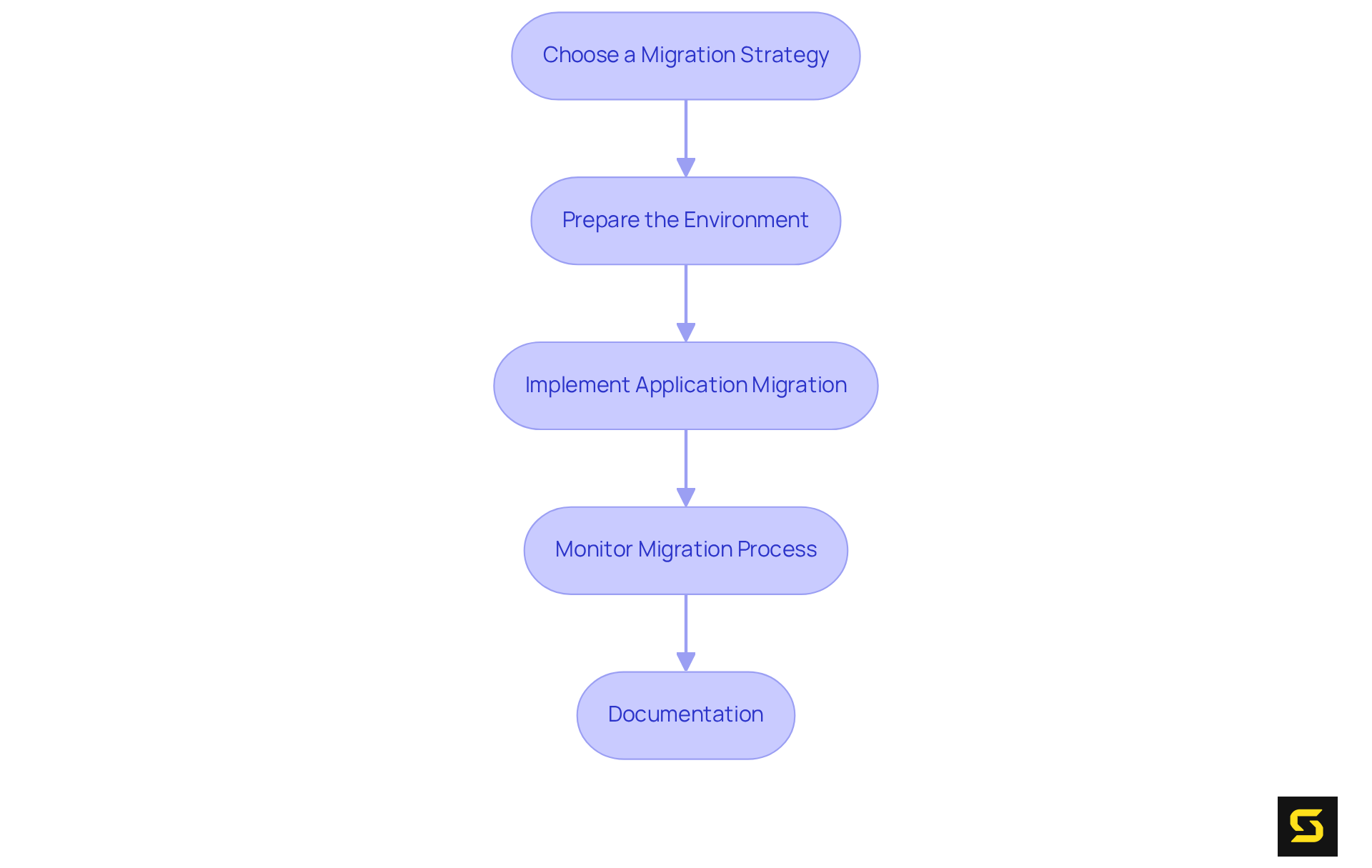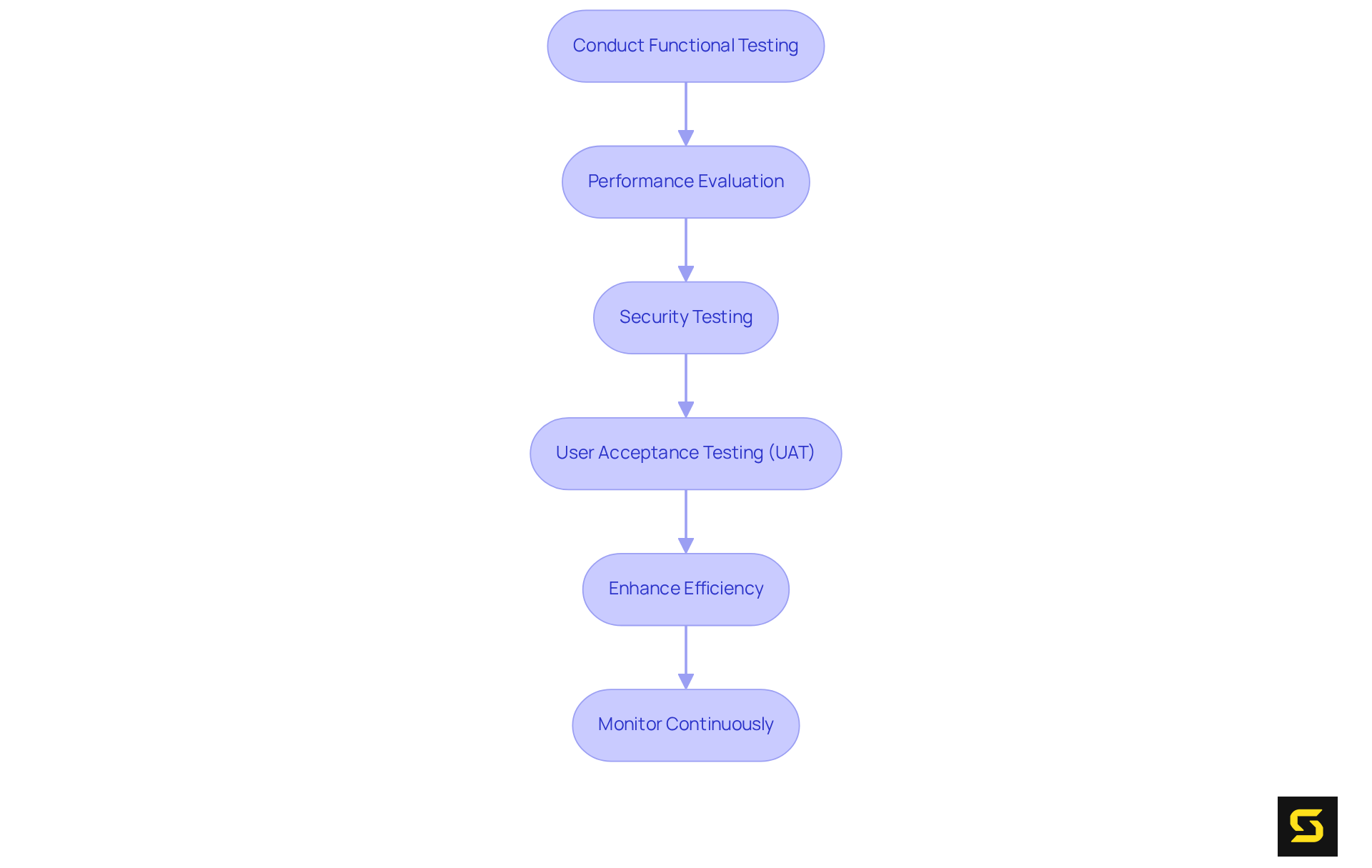Overview
The article presents a comprehensive step-by-step guide for SaaS owners aiming to master application migration effectively. It underscores the critical need to grasp migration fundamentals, evaluate current applications, implement appropriate strategies, and conduct thorough post-migration testing to secure a successful transition. This meticulous approach not only enhances operational efficiency but also significantly boosts user satisfaction.
Introduction
Navigating the complexities of application migration presents a formidable challenge for SaaS owners, particularly as the demand for cloud-based solutions escalates. This essential process not only drives modernization and scalability but also unveils opportunities for enhanced performance and cost efficiency.
Yet, alongside these promising benefits lies a host of challenges, including the risk of data loss and compatibility issues.
How can SaaS proprietors adeptly manage this transition to ensure a seamless migration while fully leveraging the advantages of cloud technology?
Understand Application Migration Fundamentals
represents a critical process in the transfer of software applications from one environment to another, particularly from on-premises infrastructure to a . This transition is essential for striving to , , and . Key concepts to grasp include:
- Types of Migration: Familiarize yourself with various migration strategies, including rehosting, replatforming, and refactoring.
- Benefits of Migration: Acknowledge the advantages such as cost savings, improved performance, and enhanced security.
- Challenges: Stay vigilant regarding potential pitfalls, including data loss, downtime, and compatibility issues that may arise during the transfer process.
By mastering these fundamentals, SaaS owners can approach the application migration process with a strategic mindset and a clearer perspective, ensuring a successful transition.

Assess Current Applications and Define Migration Goals
To effectively assess your current applications and define , adhere to the following steps:
- Inventory Programs: Compile a comprehensive list of all software currently in use, detailing their functionalities, dependencies, and user base.
- Assess Effectiveness: Examine the effectiveness of each program to identify bottlenecks, inefficiencies, and areas for improvement.
- Identify Dependencies: Outline dependencies among systems to understand their interactions and the possible effects of transition on these relationships.
- Set Clear Goals: Establish specific, measurable objectives for the migration, such as reducing , improving software performance, or . As Cody Slingerland, a FinOps certified practitioner, points out, "72% of IT experts believe will influence the utilization of SaaS solutions in the upcoming years." This underscores the necessity of having that align with broader business objectives.
- : Based on the evaluation, prioritize which programs to migrate first, considering factors such as business impact, complexity, and resource availability. For instance, migrating high-impact applications first can lead to immediate improvements in operational efficiency.
By conducting a thorough assessment and setting clear goals, SaaS owners can create a focused strategy for that aligns with their business objectives, ultimately leading to enhanced performance and user satisfaction. Furthermore, organizations should remain cognizant of potential challenges during the transition, such as security concerns and the necessity for effective cost management, as highlighted in various industry reports.

Implement Migration Strategies and Execute the Transfer
To implement effective and execute the transfer, it is essential to follow these crucial steps:
-
Choose a Migration Strategy: Select the most suitable approach based on your assessment. Common strategies include:
- Rehosting: Moving applications without significant changes, offering a fast transition.
- Replatforming: Making minimal adjustments to enhance software for the cloud environment.
- : Refactoring systems to fully leverage cloud capabilities, enhancing scalability and performance.
-
Prepare the Environment: Establish the , ensuring it meets all necessary requirements for the applications being migrated. This preparation is vital for reducing disruptions during the transfer process.
-
Application migration is an important process. Application migration entails transferring data to the new environment while prioritizing and security. A well-organized is essential; studies indicate that 67% of analytics leaders consider organizational culture a hurdle to becoming data-oriented, underscoring the importance of . Maintaining data integrity is crucial during application migration, as it directly impacts the overall success of the software transition and the future performance of the .
-
Application migration is a crucial step for many organizations. Application migration: Implement the transfer of applications based on the selected strategy, closely monitoring for any problems that may arise. A can significantly enhance operational efficiency and scalability, making it essential to proactively address potential challenges. Furthermore, utilizing integrated disaster recovery features provided by cloud providers can minimize downtime and protect business operations during the transition.
-
Documentation: Maintain detailed records of the transfer process, including challenges faced and solutions implemented. This documentation not only assists in future transitions but also contributes to enhancing strategies based on previous experiences.
By following these steps, software as a service proprietors can effectively oversee the application migration process, minimizing the chances of disruptions and ensuring a successful transfer. Highlighting data integrity during the transition is essential, as it directly influences the overall success of the software transfer and the future performance of the SaaS solution. Moreover, such as artificial intelligence and machine learning, .

Test and Optimize Applications Post-Migration
After transferring programs, it is essential to rigorously test and optimize them to ensure they perform as expected. Follow these critical steps to achieve optimal results:
- Conduct Functional Testing: Verify that all as intended in the new environment, ensuring seamless integration.
- Performance Evaluation: Assess the software's efficiency under varying loads to identify any bottlenecks or issues that may arise.
- Security Testing: Confirm that the software adheres to security standards and that data remains protected in the new environment.
- User Acceptance Testing (UAT): Involve end-users in testing to gather valuable feedback on the software's functionality and usability.
- Enhance Efficiency: Based on the , implement necessary adjustments to boost system functionality. This may include optimizing code, adjusting server configurations, or refining database queries.
- Monitor Continuously: Deploy monitoring tools to track program performance and user engagement over time, facilitating ongoing optimization.
By diligently testing and optimizing applications during application migration, SaaS owners can ensure that their applications not only operate correctly but also provide an .

Conclusion
Mastering application migration is essential for SaaS owners seeking to elevate their operational efficiency and scalability. This comprehensive guide delineates the critical steps and considerations necessary for a successful transition from on-premises infrastructure to cloud-based platforms. By grasping the fundamentals of application migration, assessing current applications, implementing effective strategies, and rigorously testing post-migration, SaaS proprietors can realize their business objectives and enhance user satisfaction.
Key insights include:
- Recognizing various migration strategies such as rehosting, replatforming, and refactoring.
- An awareness of the benefits, including cost savings and improved performance.
- The significance of establishing clear migration goals and prioritizing applications based on their impact.
- The necessity of maintaining data integrity throughout the migration process.
- The role of continuous monitoring to optimize application performance post-transfer.
Ultimately, application migration transcends mere technical execution; it embodies a strategic opportunity for SaaS owners to harness advanced technologies and enhance their service offerings. By adhering to the outlined steps and proactively addressing potential challenges, businesses can ensure a seamless transition that not only fulfills current needs but also positions them for future growth. Embracing this journey paves the way for innovation and success in an increasingly competitive landscape.
Frequently Asked Questions
What is application migration?
Application migration is the process of transferring software applications from one environment to another, particularly from on-premises infrastructure to a cloud-based platform.
Why is application migration important for SaaS proprietors?
Application migration is essential for SaaS proprietors as it helps them modernize their operations, enhance scalability, and improve overall effectiveness.
What are the different types of migration strategies?
The different types of migration strategies include rehosting, replatforming, and refactoring.
What are the benefits of application migration?
The benefits of application migration include cost savings, improved performance, and enhanced security.
What challenges might arise during the application migration process?
Potential challenges during application migration include data loss, downtime, and compatibility issues.
How can SaaS owners ensure a successful application migration?
By mastering the fundamentals of application migration, SaaS owners can approach the process with a strategic mindset and a clearer perspective, which helps ensure a successful transition.





